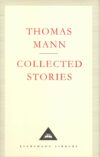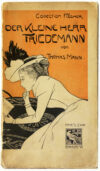Political Parables
Mann didn’t shy away from confronting the dark forces of his time. These stories are sharp commentaries on power, manipulation, and fascism.
THE TABLES OF THE LAW (1943)
Mann, Moses, and the Moral Compass
Thomas Mann’s story THE LAW was written in 1943 as a commissioned work for an anthology against Hitler. In just eight weeks, Mann crafted this text that uses the biblical story of Moses to sharply condemn National Socialism. The text culminates in a prophetic curse that unmistakably targets Hitler: A tyrant who destroys morality and laws while preaching murder, lies, and chaos. This "wise man on a golden throne" is revealed as foolish and destructive, shedding streams of blood through his "black stupidity." The passage ends with a divine promise of his complete annihilation. The greatest ironist of German literature, who otherwise valued ambiguity above all else in his texts, knew exactly: Here clarity was needed, not any kind of relativization! This must be read as a warning for today.
- Perfect if you… want to find radical anti-fascism in Thomas Mann’s stories as well.
- Reading time: approx. 2 hours
- Notable Quote: “Moses, however, impressed by his desire for purity and holiness, was deeply moved by Yahweh’s invisibility; he found that no visible god could match an invisible one in holiness [...].”
- Trivia: Thomas Mann quoted the conclusion of the story verbatim (this time with explicit reference to Hitler) in his GERMAN LISTENERS address on April 25, 1943.
MARIO AND THE MAGICIAN (1930)
Power, Manipulation, and Fascism
A story about a magician who is actually a malevolent hypnotist—and pays for it with his life. A parable about the suggestive power of fascism—eerily relevant.
- Perfect if you… have always found hypnosis eerie and politically suspicious.
- Reading time: approx. 1 hour
- Notable Quote: “Freedom exists, and so does the will; but free will does not exist because a will that directs itself towards its freedom runs into emptiness.”
- Trivia: Mann incorporated impressions from a summer vacation in Mussolini’s Italy into this story.
Identity Crises and Social Isolation
Mann’s fascination with outsiders grappling with their place in society is at the heart of these deeply personal narratives.
TONIO KRÖGER (1903)
The Possibility of a Thousand Forms of Existence
Tonio Kröger begins as a coming-of-age story about a boy who finds himself in an outsider role due to his background and sexual orientation. Thomas Mann demonstrates in this story that even as an adult, identity is never complete or absolute but as changeable and diverse as the society one faces.
- Perfect if you… always feel like you don’t quite belong anywhere.
- Reading time: approx. 45 minutes
- Notable Quote: “I stand between two worlds, belong to neither, and consequently have it somewhat hard.”
- Trivia: Thomas Mann identified deeply with this novella and considered it one of his most personal works throughout his life. This is particularly evident in a letter to the Ehrenberg brothers from 1903, which he signed as “Your Tonio Kröger.”
LITTLE HERR FRIEDEMANN (1897)
The Productivity of Unfulfilled Longings
Young Thomas Mann explores his core themes and techniques: LITTLE HERR FRIEDEMANN tells with subtle linguistic artistry and keen observation the story of an outsider who fails due to unfulfilled desires. Socially, politically, and literarily rooted in the late 19th century, this novella marks an early milestone in Mann's career as an author—a key story for his later texts and an appetizer for those looking forward to the complexity of his great novels.
- Perfect if you… seek the balance between ironic distance and melancholic empathy.
- Reading time: approx. 30 minutes
- Notable Quote: “He learned to understand that everything is enjoyable and that it is almost foolish to distinguish between happy and unhappy experiences.”
- Trivia: A presumed earlier version of the novella was rejected for publication; LITTLE HERR FRIEDEMANN, however, established Mann's enduring connection with S. Fischer Verlag
Existential Explorations: Love, Death, and Metaphysical Boundaries
These stories dive into life’s biggest questions—often with mythological or philosophical twists.
Trailer of the movie ORG directed by Fernando Birri (1979), based on Thomas Mann's 1940s novella THE TRANSPOSED HEADS. The film adaptation reimagines Mann's Indian-inspired tale through Birri's experimental cinematic vision.
THE TRANSPOSED HEADS (1940)
Mythology Meets Grotesque
Published in 1940 as THE TRANSPOSED HEADS: A LEGEND OF INDIA, this novella blends Indian mythology with European storytelling traditions. With irony and philosophical depth, Mann explores themes such as love, identity, and body-mind dualism while contrasting Western notions of individuality with Eastern concepts of reincarnation and harmony.
“Trigger warning”: Not for the faint-hearted—the plot is extremely gruesome...
- Perfect if you… often wonder what defines you: your head or your body?
- Reading time: approx. 1 hour
- Notable Quote: “In short: asceticism is a bottomless barrel; it is an unfathomable thing because spiritual temptations mingle with sensual ones within it—and dealing with it is like dealing with a snake whose two heads grow back when one is cut off.”
- Trivia: The novella is based on an Indian legend from the Kathāsaritsāgara, a famous 11th-century collection of Indian legends and folk tales.
DEATH IN VENICE (1912)
When Beauty Becomes Obsession
DEATH IN VENICE reads like a psychological thriller about a man who has everything to lose—and does so with terrifying determination. The story of aging writer Gustav von Aschenbach falling fatally in love with a Polish boy in Venice develops an irresistible pull. The cholera-stricken lagoon city becomes the perfect backdrop for a drama about the discrepancy between outward appearance and inner turmoil. With precision that cuts deep under your skin, Mann tells of the destructive power of obsession.
- Perfect if you… have always wanted to know how to fall apart with maximum elegance.
- Reading time: approx. 3 hours
- Notable Quote: “And, as he had done so often, he set out to follow him”
- Trivia: The character Tadzio is based on a Polish boy whom Mann observed at the Grand Hôtel des Bains in 1911—something the boy only learned decades later.
Everyday Observations with Societal Depth
Mann transforms mundane moments into profound reflections on human nature and societal change.
DISORDER AND EARLY SORROW (1925)
Post-War Era and Generational Conflict
Inflation rages through the daily life of the Cornelius family, a history professor with many children. Prices for rationed goods skyrocket astronomically (eggs for 6,000 marks!). "Disorder" spreads not only during a dance party hosted by the children in their Munich villa but also in politics and society. Despite this, the story is written with a light touch and also revolves around the "early sorrow" of the youngest daughter Lorchen's (Elisabeth's) first unhappy love. It is a subtle depiction of a society drained of vitality by inflation and on the brink of authoritarianism, as well as a humorous, semi-autobiographical family portrait.
- Perfect if you… can’t get enough of generational conflicts, even after endless debates about “Boomers” and “Zoomers.”
- Reading time: approx. 45 minutes
- Notable Quote: “What luck, he thought, that […] such a children's night forms a deep and wide abyss between one day and another!”
- Trivia: Thomas Mann supposedly wrote this story to take a break from working on THE MAGIC MOUNTAIN.
A MAN AND HIS DOG (1919)
A Mann's best Friend
Every morning on my way to Monacensia, I see dog walkers in Bogenhausen—a parade of symbioses that mostly seems harmless. But Thomas Mann penetrates this idyll with clever irony: A MAN AND HIS DOG is more than a charming anecdote about the quirks of a four-legged friend. Bauschan, the dog, is both a loyal companion to the narrator and an incomprehensible being—familiar yet distant. With this masterful blend of affection and skeptical detachment, Mann created a literary text that goes far beyond mere love for animals.
- Perfect if you… want to hear about stick-fetching from a Nobel laureate in literature.
- Reading time: approx. 45 minutes
- Notable Quote: “At the beginning of the avenue, I can still see him sitting there as a small, dark, clumsy dot in the middle of the road […]. He had waited so long, and one knows how torturous waiting can be!”
- Trivia: The real Bauschan was Mann’s beloved fox terrier.
Artistic Reflection and Moral Ambiguity
These stories probe the intersection of creativity, ethics, and societal norms.
A RAILWAY ACCIDENT (1909)
An Unexpected Stop
A misaligned switch leads to a collision between a night train and a freight train. Among the shaken passengers is a writer who fears for his manuscript stored in the luggage car. A RAILWAY ACCIDENT temporarily disrupts the rigid order of the Wilhelmine Empire. A masterful short novella that foreshadows the upheavals of the 20th century—and a text about an author’s primal fear: that manuscripts might be destroyed.
- Perfect if you… are a fan of literary derailments.
- Reading time: approx. 20 minutes
- Notable Quote: “I like traveling in comfort, especially when someone else pays for it.”
- Trivia: Thomas Mann himself experienced a train accident near Regensburg on May 1, 1906 unscathed.
GLADIUS DEI (1902)
Art, Morality, and Fanaticism
Gladius Dei is a razor-sharp satire on Munich’s art scene at the time—and simultaneously a burning commentary on artistic freedom, religious zealotry, and wounded feelings. In times of monument-toppling debates about censorship and moral outrage, Mann’s irony hits home. Provocative, clever, timeless—a must-read for anyone wanting to understand where art ends and conflict begins!
- Perfect if you… have ever felt tempted to throw soup at artworks yourself.
- Reading time: approx. 30 minutes
- Notable Quote: “Munich shone.”
- Trivia: The protagonist Hieronymus is inspired by Girolamo Savonarola, the fanatical Renaissance preacher known for burning artworks in ritualistic pyres. His fervor serves as the foundation for Thomas Mann’s ironically parodic tale.
Thomas Mann: Collected Stories (Everyman's Library Classics)
This comprehensive collection, published in 2001 by Everyman's Library, brings together Thomas Mann's most celebrated short stories, offering a rich exploration of his mastery across various themes and styles. The hardcover edition spans 920 pages, making it a treasure trove for readers interested in Mann's shorter fictions. Translated by H.T. Lowe-Porter, this edition provides a classic introduction to Mann's shorter works.

Thomas Mann: New Selected Stories
This vibrant collection, published by Liveright Publishing Corporation in 2023, offers fresh translations of Thomas Mann's most captivating short stories. Award-winning translator Damion Searls brings to life Mann's humor and poignancy, challenging the common perception of Mann as a dry writer. Searls' translations breathe new life into Mann's prose, making these stories feel both modern and timeless. This collection is a perfect introduction for new readers and a rediscovery for those familiar with Mann's work, highlighting his sly humor, warmth, and erudition.










